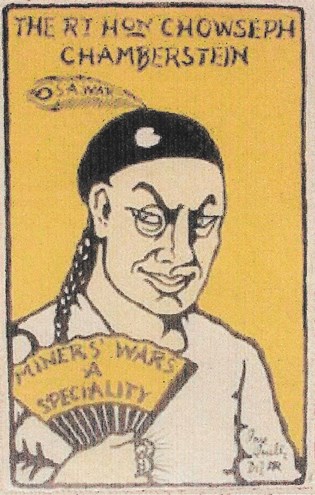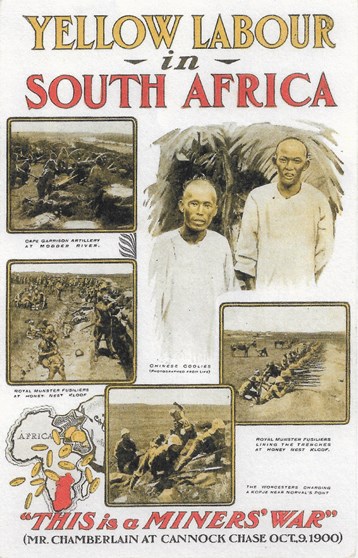
Jeff Woolgar
PROPAGANDA CARTOON PICTURE POSTCARDS PUBLISHED BY KNIGHT BROTHERS RELATING TO THE CHINESE LABOUR EXPERIMENT IN THE TRANSVAAL
JOSEPH CHAMBERLAIN
Woolgar, J., 2010, Propaganda cartoon picture postcards published by Knight Brothers relating
to the Chinese Labour Experiment in the Transvaal – Joseph Chamberlain, (173), pp.18-19
Introduction
Between 1904 and 1910, 63,296 indentured Chinese labourers worked on the Transvaal (Witwatersrand) Gold Mines. In London the Liberals under Sir Henry Campbell-Bannerman, who had been a critic of the policies that led to the Second African War (1899 - 1902), and to the scorched earth campaign of Kitchener, criticised the policy of Chinese indentured labour on the mines, accusing the Conservatives of introducing a ‘new element into the confusion already existing’. The Radical Liberals pressed their case and their electoral campaign with words such as ‘slavery’.*

The above picture postcard printed in three colours; yellow, fawn and black and published by Knight Brothers of London, was illustrated in a Newsletter of the Southern Africa Postcard Research Group1, where it was thought somewhat obscure and no satisfactory conclusion as to the date of the postcard could be determined. The cartoon is of Joseph Chamberlain (1836-1914) dressed as a Chinaman with a feather in his cap on which is written 'S.A.WAR'. Diamond ringed fingers hold a fan on which is written 'MINERS’ WARS A SPECIALITY' and the caption at the top reads 'THE RT HON CHOWSEPH CHAMBERSTEIN'. The divided back (address side) is printed in apple-green and records that this postcard was number '11' in the series.
My research has revealed that the publishers, Knight Brothers, Dyer’s Buildings, Holborn, London EC, published postcards as part of their “Porcupine Series of Topical & Political Postcards” and that the firm was only founded in 1904. The Porcupine trademark was not registered until August 1905, and the Company ceased around 1908.2 Hence this postcard is a post Boer War production from the period when British newspapers and magazines were still keen to publish caricatures of Chamberlain. Moreover, the first ship carrying indentured Chinese mine labourers to work on the Witwatersrand gold mines did not arrive at Bluff Wharf, Port Natal until 18th June 1904.

Illustrated here is another picture postcard printed in three colours and published by Knight Brothers from their ' “Porcupine Series of Topical and Political Postcards” ' (No 10 with undivided back) headed 'YELLOW LABOUR in SOUTH AFRICA'. Four of the six pictures were taken from photographs of battles which are captioned from top to bottom:
'CAPE GARRISON ARTILLERY AT MODDER RIVER.'
'ROYAL MUNSTER FUSILIERS AT HONEY NEST KLOOF'
'ROYAL MUNSTER FUSILIERS LINING THE TRENCHES AT HONEY NEST KLOOF.'
'THE WORCESTERS CHARGING A KOPJE NEAR NORVAL’S PONT'
The other two are drawings, one of Chinese Coolies and the other a map of Africa. British territories in Southern Africa are in red, and gold coins are falling from a money bag. Finally the whole is captioned ' “THIS is a MINERS’ WAR” / (MR. CHAMBERLAIN AT CANNOCK CHASE OCT.,9,1900)'.
However, was Joseph Chamberlain actually at Cannock Chase on the 9th October 1900?
Joseph Chamberlain was away from home on 9th October 1900, campaigning for the Unionist Party in the General Election – the so called Khaki Election. His letters to his wife were more like dispatches but on this day he wrote “It is very warm with a beautiful breeze from the west. I hope it may continue for a day or two ...”.3 His campaign was an attack on the Liberals and he was willing to use the recent military gains reported from South Africa to his advantage. However, he does not appear to have given a speech at Cannock Chase on the 9th October, but did give a speech to Staffordshire miners at Cannock Chase on the previous day, 8th October, in support of the candidature of Captain W.B. Harrison. Chamberlain told his audience that many miners in the north of England were for the first time supporting the Unionist party and urged Staffordshire miners to follow their example. Concerning the South African War he told the meeting that military administration would remain as long as there was organised resistance and when that time came to an end, as he hoped it would in a few weeks or days, they would substitute for it the civil administration of a Crown Colony Government similar to that which existed in Trinidad, Jamaica and Ceylon and when the Boers had accepted the situation, we would give to them the same kind of government as we had already given to Australia, Canada, and the Cape, and the Boers would thereafter enjoy more liberty than they had before.4
The result of the 1900 General Election was a majority of 134 seats to Lord Robert Salisbury’s Conservative / Unionist Alliance over the Liberals and others and Joseph Chamberlain kept his position as Colonial Secretary.
When Lord Robert Salisbury stepped down in 1902 due to ill health, his nephew Arthur J. Balfour succeeded him (hence the phase ‘Bob’s your Uncle’). During Balfour’s tenure as Prime Minister his Conservative party, and the Unionist party under Chamberlain drifted apart, resulting in Balfour’s resignation during December 1905. The General Election of 1906 resulted in a landslide victory for the Liberals. It must have been about this time that the two postcards illustrated here were published.
Conclusion
Even though he had long ceased to be Secretary of State for the Colonies (resigning on 16th September, 1903) or involved in decisions of the Cabinet, Chamberlain continued to be a popular subject for newspaper cartoonists for many years. He understood that Chinese labour would be unpopular and did not wish to go against public opinion either in South Africa or at Home. However, he remained in the public gaze and supported the Balfour administration during April 1904, once they had devised a procedure for employing Chinese indentured labour on the Rand. There are scores of picture postcards which portray Joseph Chamberlain, not all of which were of a derogatory nature. Cartoons of him dressed as a Chinaman date from at least July 1904.5
These are propaganda postcards par excellence. Pictures of Chinese at the time were summed up by Graham Wallas in his book Human Nature in Politics6 'Any one ... who saw much of politics in the winter of 1905-6 must have noticed that the pictures of Chinamen on the hoardings aroused among very many of the voters an immediate hatred of the Mongolian racial type. This hatred was transferred to the Conservative party, and towards the end of the general election of 1906 a picture of a Chinaman thrown suddenly on a lantern screen before a working-class audience would have aroused an instantaneous howl of indignation against Mr. Balfour.'
References
1 Newsletter, (1997) incorrectly dated 1996), Southern Africa Postcard Research Group, Isle of Man, p.9.
2 Byatt, A., (1978), Picture Postcards and their Publishers, Golden Age Postcard Books, Malvern, pp.147-148.
3 Garvin, J.L., (1934), The Life of Joseph Chamberlain, volume three 1895-1900, Empire and World Policy, Macmillan and Co, Ltd. London, Chapter LXXIV, p.603.
4 The Manchester Guardian, Tuesday 9th October, 1900, p.4
5 The Westminster Gazette, 19th July 1904
6 Wallas G., (1908) fourth edition 1948), Human Nature in Politics, London pp.107-108
* Taken from page 16 of: - -'Witwatersrand Chinese Labour'. --
Acknowledgements
I am indebted to Joan Matthews, Michael Walker and the late Ken Gibbon for providing scans and information from the reverse of these cards.
- - 'Chinese Labour Johannesburg'. - -
Copyright © J Woolgar 2010 and 2020